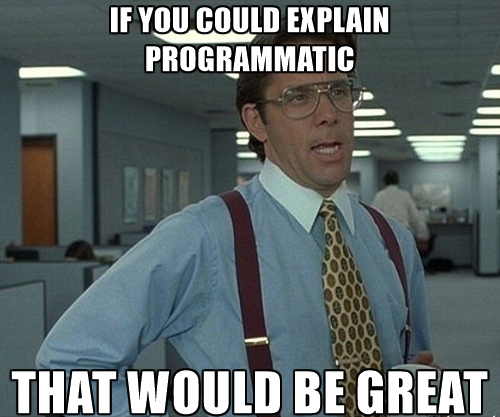ATD, CPL, DSP, CPA, SDK…
Is this even English?
*This is part 1 of a series, The Ultimate ABCs of Programmatic.
ATD, CPL, DSP, CPA, SDK…Is this even English?
No, you didn’t just read a string of nonsense.
These acronyms, which I’m sure you’re always hearing Ad Ops throw about, are actually representative of important elements of Programmatic Advertising.
But let’s admit it, they can be incredibly confusing.

In this series, “The Ultimate ABCs of Programmatic Advertising,” we set out to get you fluent with all the specific programmatic media buying terms and acronyms.
If you’re new to programmatic, this series is for you. Keep reading!
In Programmatic Advertising,
“A” is for…
Ad Server
A technology that offers the means to store and delivers advertisements onto digital platforms including websites, social media, and apps. Ad serving companies also function to count clicks or impressions of ads to help advertisers track their campaigns and return on ad spend (ROAS).
Ad Space
An area of a digital platform, including websites, social media, and apps, that is reserved for displaying online advertisements.
Ad Exchange
Often likened to stock markets, an ad exchange is a virtual marketplace that allows advertisers and publishers to buy and sell ad space usually through real-time auctions. Ad types sold on exchanges can be display, video, and mobile inventory and winning impressions are determined by a set bid price in combination with historical user behaviour, time of day, geographic-location, and device.
Exchanges are beneficial to advertisers because they allow ads to be bought at scale, that is, across a large array of digital platforms at once as opposed to individual, time-consuming direct buys.
Examples: DoubleClick by Google, BrightRoll by Yahoo, Rubicon Project, AppNexus, OpenX etc.
Ad Exchange, Open (Public)
Open ad exchanges, A.K.A public exchanges, are virtual marketplaces that allows advertisers and publishers to buy and sell ad space. Open exchanges are publicly accessible to any advertiser or publisher. Open exchanges have come under fire for a lack of accountability, problems with ad fraud and reliance on third-party data which can limit audience targeting.
Ad Exchange, Closed (Private)
Closed ad exchanges, A.K.A private exchanges, are virtual marketplaces that allow advertisers and publishers to buy and sell ad space. Private exchanges are not publicly accessible to just any advertiser or publisher.
Private exchanges are much more controlled environments where only select advertisers and publishers are invited in to buy and sell. Private exchanges, often run by a large group of publishers, are growing in popularity as they are seen as safer environments with less fraud, as well as first-party data to improve audience targeting.
Ad Network
A company that connects a large number of websites and aggregates ad inventory to sell for a profit. Ad networks originally came about as a way of offering advertisers scale and audience reach. Premium content has historically not been a major concern for ad networks.
Ad networks have been criticized for driving the cost of inventory up as they can and have broker sales between themselves causing the daisy chain problem.
Examples: AdSense, BuySellAds, Conversant etc.
Agency Trading Desk (ATD)
Agency Trading Desks (ATD) are the in-house programmatic ad buying team in advertising agencies. ATDs offers real-time ad and audience buying as a managed service for clients.
Typically the inventory made available through ATDs have been described as remnant publisher inventory – the same inventory sold to ad networks. Complaints about ATDs have arisen around the issue of double paying agencies for both agency services and trading desk services, or conflicts of interest between buyer and seller.
Awareness
The first stage of a full-funnel marketing or purchasing model. Awareness precedes interest, consideration, conversion (and loyalty and advocacy) in the buyer journey and encompasses the moment when potential customers first learn about a product or service.
In the context of programmatic advertising, running awareness campaign is an important prospecting process to help identify potential users or customers. By tracking and measuring ad performance, for example, full video views, early in the buyer process, programmatic media buyers can strategize on how to target these prospects (based on interest) later in the funnel and drive them towards conversion.
If you didn’t know, now you know.
Stay tuned for more in upcoming posts in this series. Next up, we explore and define the Bs and Cs of Programmatic.
Want to learn more? Connect with our team at sales@clearpier.com